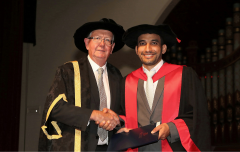
Receiving his PhD last week, Dr Nagi Abdussamie's research investigated how the design of offshore oil and gas structures makes them vulnerable to damage from extreme waves — and how design modifications could help them survive.
Rogue waves — typically caused by cyclones or hurricanes — can have a devastating effect on offshore oil and gas structures as they exert extreme forces that can prove too much for the structures to withstand. This was the case in the Gulf of Mexico in 2004 and 2005, when 118 platforms were decimated by Hurricanes Ivan, Rita and Katrina.
As such extreme weather conditions become more frequently observed across the globe, understanding how to respond to them becomes increasingly important.
Dr Nagi Abdussamie, a recent PhD graduate and lecturer at the Australian Maritime College, has spent the last three years devoted to this topic. His PhD investigated how the design of offshore oil and gas structures makes them vulnerable to damage from rogue waves, and how design modifications could help the structures survive.
To tackle these questions, he created physical scale models of the oil and gas structures and generated rogue waves using AMC’s towing tank facility, enabling him to observe and record exactly how the model structures were impacted.
He then took advantage of powerful computing resources at AMC to undertake numerical modelling using a method called Computational Fluid Dynamics (CFD), which successfully validated the experimental data. Compared to model scale experiments, CFD provides a more detailed insight into how the extreme forces upon the structure are generated.
“The biggest challenge I faced was developing an accurate numerical model for such a problem and verifying numerical results against experimental data,” said Dr Abdussamie.
His research focused on the platform deck; the topside of the structure, which sits above the sea level and has equipment installed upon it. The deck is designed to sit outside the ‘splash zone’, which means that over a period of either 100 or 1,000 years a wave could not be expected to reach it.
Because of this, most platforms that exist today are not designed for the possibility that the deck could be hit by a wave. But, in the last decades, there have been cases when the topside was damaged by a rogue wave — an occurrence that was also observed by Dr Abdussamie during his modelling.
Based on his findings, Dr Abdussamie concludes that offshore oil and gas structure designs must consider the deck — which should be designed to withstand the highest wave that could be expected to occur over 10,000 years.
This could be done by increasing the air gap — the space between the sea level and the topside — although changing the centre of gravity could affect the structure’s stability. An alternative solution would be to reinforce areas of the topside structure to ensure they can withstand such rare waves: this would rely on research such as Dr Abdussamie’s to understand the exact load that the structure must endure.
Dr Abdussamie has been prolific during his PhD, publishing two papers, with a further three under review, and presenting his research at eight international conferences. Undergraduates at AMC will benefit from his expertise as he stays on at the College, teaching ocean engineering units.
“Teaching at AMC is very exciting, I am always motivated by students’ feedback, which keeps me reading and searching new concepts.
“Research and teaching enables me to share my previous field experience with ocean engineering students in the class room,” he explains.
Published on: 22 Dec 2016
